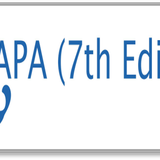TAM Towards Leddite Building Mandors In The Use Of E-Filing
DOI:
https://doi.org/10.24912/ja.v24i1.660Abstract
This study aims to identify perceptions of usefulness, convenience and attitude towards behavior in the use of e-filling. Data from this study were obtain through quesstionnaires distributed to the community in the category of technological stuttering and had produced 50 respondents consisting of construction foremen in PT. Hutama Karya (Persero) Surabaya Brach. This study had a result that found if the variable perceeived usefullness and perceived easse of being has a possitive and siignificant effecct onthe use of, e-filling, but the attitude towards the most behavior did not affect the use of e-filling. This study hal limitation is that it only uses 1 company as a research sample, so it is less able to generalize these findings.
References
Abbas, H. A., and Hamdy, H. I. (2015). Determinants of Continuance Intention Factor in Kuwait Communication Market: Case study of Zain-Kuwait. Computers in Human Behavior, 49, 648-657.
Alsabawy, A. Y., Cater-Steel, A., and Soar, J. (2016). Determinants of Perceived Usefulness of E-learning Systems. Computers in Human Behavior, 64, 843-858.
Baker-Eveleth, L., and Stone, R. W. (2015). Usability, Expectation, Confirmation, and Continuance Intentions to Use Electronic Textbooks. Behaviour & Information Technology, 34(10), 992-1004.
Chen, J. V., Jubilado, R. J. M., Capistrano, E. P. S., and Yen, D. C. (2015). Factors Affecting Online Tax Filing–An Application of The IS Success Model and Trust Theory. Computers in Human Behavior, 43, 251-262.
Chiu, C.-M., and Wang, E. T. (2008). Understanding Web-based Learning Continuance Intention: The Role of Subjective Task Value. Information & management, 45(3), 194-201.
Davis, F. D. (1989). Perceived Usefulness, Perceived Ease of Use, and User Acceptance of Information Technology. MIS quarterly, 319-340.
Dorasamy, M., Marimuthu, M., Raman, M., and Kaliannan, M. (2012). E-Government Services Online: An Exploratory Study on Tax E-filing in Malaysia Technology Enabled Transformation of the Public Sector: Advances in E-Government (pp. 312-325): IGI Global.
Faaeq, M. K., Ismail, N. A., Osman, W. R. S., Al–Swidi, A. K., and Faieq, A. K. (2013). A Meta–Analysis of The Unified Theory of Acceptance and Use of Technology Studies Among Several Countries. Electronic Government, an International Journal, 10(3-4), 343-360.
Gangwar, H., Date, H., and Ramaswamy, R. (2015). Understanding Determinants of Cloud Computing Adoption Using an Integrated TAM-TOE Model. Journal of enterprise information management.
Ghozali, I. (2011). Aplikasi Analisis Multivariate Dengan Program IBM: Spss.
Harris, M. A., and Weistroffer, H. R. (2009). A New Look At The Relationship Between User Involvement In Systems Development and System Success. Communications of the Association for Information Systems, 24(1), 42.
Hsieh, P.-A. J., and Cho, V. (2011). Comparing e-Learning Tools’ Success: The Case of Instructor–Student Interactive vs. Self-Paced Tools. Computers & education, 57(3), 2025-2038.
Hussein, R., Karim, N. S. A., and Selamat, M. H. (2007). The Impact of Technological Factors on Information Systems Success In The Electronic‐Government Context. Business Process Management Journal.
Ibrahim, I. (2014). The Compliance Time Costs of Malaysian Personal Income Tax System: E-filers vs. Manual-Filers. Procedia-Social and Behavioral Sciences, 164, 522-527.
Peraturan Direktorat Jenderal Pajak Nomor PER-06/PJ/2014 tentang Tata Cara Penyampaian Surat Pemberitahuan Tahunan Bagi Wajib Pajak Orang Pribadi Yang Menggunakan Formulir 1770S atau 1770SS Secara e-Filing dan Merupakan Pegawai Tetap Pada Pemberi Kerja Tertentu, (2014).
Peraturan Direktorat Jenderal Pajak Nomor PER-03/PJ/2015 Penyampaian Surat Pemberitahuan Elektronik, (2015).
Indonesia, P. R. (2009). Undang-Undang Republik Indonesia Nomor 16 TAHUN 2000. Available in: http://peraturan. go. id/uu/nomor-10-tahun-2009. html [accessed on 21 March 2016].
Johnson, R. D., Hornik, S., and Salas, E. (2008). An Empirical Examination of Factors Contributing to The Creation of Successful E-learning Environments. International Journal of Human-Computer Studies, 66(5), 356-369.
Joo, Y. J., Lim, K. Y., and Kim, E. K. (2011). Online University Students' Satisfaction and Persistence: Examining Perceived Level of Presence, Usefulness and Ease of Use As Predictors In a Structural Model. Computers & education, 7(2), 1654-1664.
Koumbiadis, N., Okpara, J. O., Pandit, G. M., and Ritsatos, T. (2014). Tax Evasion and Compliance; From The Neo Classical Paradigm to Behavioural Economics, A Review. Journal of Accounting & Organizational Change.
Krishna, R. (2017). The Impact of Health Information Technology on The Doctor-Patient Relationship in Child and Adolescent Psychiatry. Child and Adolescent Psychiatric Clinics, 26(1), 67-75.
Laihad, R. C. (2013). Pengaruh Perilaku Wajib Pajak terhadap Penggunaan E-Filing Wajib Pajak di Kota Manado. Jurnal EMBA: Jurnal Riset Ekonomi, Manajemen, Bisnis dan Akuntansi, 1(3).
Laudon, K. C., dan Laudon, J. P. (2005). Sistem Informasi Manajemen Mengelola Perusahaan Digital. Edisi VIII. Andi. Yogyakarta.
Lean, O. K., Zailani, S., Ramayah, T., and Fernando, Y. (2009). Factors Influencing Intention to Use E-government Services Among Citizens in Malaysia. International Journal of Information Management, 29(6), 458-475.
Lee, M.-C. (2009). Factors Influencing The Adoption of Internet Banking: An Integration of TAM and TPB With Perceived Risk and Perceived Benefit. Electronic commerce research and applications, 8(3), 130-141.
Liang, S. w., and Lu, H. p. (2013). Adoption of E-government Services: An Empirical Study of The Online Tax Filing System in Taiwan. Online Information Review.
Lie, I., and Sadjiarto, R. A. (2013). Faktor-Faktor Yang Mempengaruhi Minat Perilaku Wajib Pajak Untuk Menggunakan e-Filing. Tax & Accounting Review, 3(2), 147.
Limayem, M., and Cheung, C. M. (2008). Understanding Information Systems Continuance: The Case of Internet-Based Learning Technologies. Information & management, 45(4), 227-232.
Liu, J., and Hu, C.-z. (2017). Application of Information Technology in Active Safety Control for Construction Machine. Procedia engineering, 174, 1182-1189.
Mohammadi, F., Abrizah, A., and Nazari, M. (2017). Is The Information Fit For Use? Exploring Teachers Perceived Information Quality Indicators For Farsi Web-Based Learning Resources. Malaysian Journal of Library & Information Science, 20(1).
Noor, N. L. M., Harun, A. F., Adnan, W. A. W., Saman, F. M., and Noh, M. A. M. (2016). Towards The Conceptualization of Citizen User Experience: Citizens' Preference for Emotional Design in E-Government Portal. Paper presented at the 2016 4th International Conference on User Science and Engineering (i-USEr).
Novickis, L., Mitasiunas, A., and Ponomarenko, V. (2017). Information Technology Transfer Model as a Bridge Between Science and Business Sector. Procedia Computer Science, 104, 120-126.
Novrinda, I. (2014). Pengaruh Persepsi Wajib Pajak Orang Pribadi Terhadap Penggunaan Electronic Filing (E-Filing) Di KPP Pratama Palembang Ilir Barat. Politeknik Negeri Sriwijaya.
Oni, A. A., Adewoye, O. J., and Eweoya, I. O. (2016). E-banking Users’ Behaviour: E-service Quality, Attitude, and Customer Satisfaction. International Journal of Bank Marketing.
Pandiangan, L. (2013). Modernisasi dan Reformasi Pelayanan Perpajakan: Elex Media Komputindo.
Saad, R. A. J., and Haniffa, R. (2014). Determinants of Zakah (Islamic tax) Compliance Behavior. Journal of Islamic Accounting and Business Research.
Santhanamery, T., and Ramayah, T. (2015). Understanding The Effect of Demographic and Personality Traits on The E-filing Continuance Usage Intention in Malaysia. Global Business Review, 16(1), 1-20.
Sesa, E. S. (2014). Pengaruh Persepsi Wajib Pajak Orang Pribadi Pada Penerapan e-Filing Terhadap Kepatuhan Dalam Menyampaikan SPT Tahunan di Kota Surabaya. Universitas Pelita Harapan Surabaya-Faculty Of Business School-Department Of.
Setiawan, D., Kurniawan, B., dan Payamta, P. (2018). Dampak penggunaan e-filling terhadap kepatuhan wajib pajak: peran perilaku wajib pajak sebagai variabel mediasi. Jurnal Akuntansi dan Auditing Indonesia, 22(1), 12-24.
Shao, B., Luo, X., and Liao, Q. (2015). Factors Influencing E-tax Filing Adoption Intention By Business Users in China. Electronic Government, an International Journal, 11(4), 283-305.
Siahaan, M. P., dan SE, M. (2013). Pajak Daerah & Retribusi Daerah: Berdasarkan Undang-Undang Nomor 28 Tahun 2009 tentang Pajak Daerah dan Retribusi Daerah. Jakarta: Rajawali Pers.
Spitzer, M. (2014). Information Technology In Education: Risks and Side Effects. Trends in Neuroscience and Education, 3(3-4), 81-85.
Tallaha, A. M., Shukor, Z. A., and Hassan, N. S. A. (2014). Factors Influencing E-Filing Usage Among Malaysian Taxpayers: Does Tax Knowledge Matters? Jurnal Pengurusan (UKM Journal of Management), 40.
Teoh, W. M. Y., Chong, S. C., Lin, B., and Chua, J. W. (2013). Factors Affecting Consumers’ Perception of Electronic Payment: An Empirical Analysis. Internet Research.
Widiartanto, Y. H. (2018). 10,59 Juta SPT Masuk, 80 Persen Melalui E-Filing. Retrieved from https://ekonomi.kompas.com/read/2018/04/02/101100226/10-59-juta-spt-masuk-80-persen-melalui-e-filing.
Zhao, J., Chi, M., Zhu, Z., and Hu, L. (2015). From Digital Business Strategy to E-business Value Creation: a Three-Stage Process Model. International Journal of Networking and Virtual Organisations, 15(2-3), 215-241.
Downloads
Published
How to Cite
Issue
Section
License
Copyright (c) 2020 Jurnal Akuntansi

This work is licensed under a Creative Commons Attribution-NonCommercial-ShareAlike 4.0 International License.
This journal provides immediate open access to its content on the principle that making research freely available to the public supports a greater global exchange of knowledge.

This work is licensed under a Creative Commons Attribution-NonCommercial-ShareAlike 4.0 International License



















